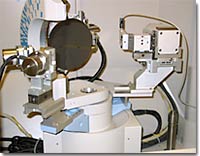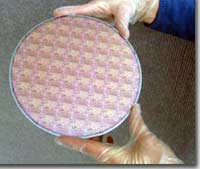Patricia Mooney
"For me, physics is done in a community, and research involves social interactions," says Patricia Mooney. In the course of her career, Mooney has experienced a broad range of physics communities. From her first jobs as assistant professor of physics at two small liberal arts colleges, Hiram College (in Ohio) and Vassar College, and research positions at SUNY Albany and a French government laboratory in Paris, Mooney moved on to become a member of the research staff in one of the largest industrial laboratories in the world - IBM's T. J. Watson Research Center in Yorktown Heights, NY. "I enjoyed teaching a lot, but I've also been very happy at IBM."

An 8" diameter wafer is mounted on a high resolution x-ray diffractometer in Patrica Mooney's laboratory. X-ray measurements reveal the alloy composition and degree of strain relaxation of the silicon-germanium (SiGe) layer grown on a silicon wafer. Dr. Mooney has used x-ray diffraction for the last 10 years or so to study strain relaxation mechanisms in SiGe films. These experiments were done using using both laboratory x-ray systems and synchrotrons.

This is an 8" diameter wafer with strained silicon transistors fabricated on it. Charge carriers (negatively charged electrons and positively charged holes) are more mobile in strained silicon compared to the usual bulk silicon, resulting in faster transistors. IBM is developing this technology for future electronic chip applications.
She has been very successful as well; since she began working at IBM in 1980, Mooney has won two of the company's Outstanding Achievement Awards. The first award acknowledged her contribution to clarifying some of the unusual electrical conduction properties of the semiconductor aluminum gallium arsenide (AlGaAs), and the second award recognized her work on electrical conduction in strained silicon. The primary focus of her current research is on developing faster electronics that rely on strained silicon. "Basically," explains Mooney, "a thin layer of crystalline silicon is grown on top of a thick crystalline layer of silicon germanium (SiGe). Because the atom spacings in the two crystals are slightly different, the silicon layer becomes stretched. That can increase the speed of charge carriers in an electrical circuit built of the strained material," leading to faster microelectronic chips.
Mooney and her colleagues hope to get strained silicon devices to the market place within the next few years, a goal that Mooney says is both exciting and demanding. "In industry the competitive pressures are enormous," says Mooney. "Not only do you have to do it, but you have to do it before your competitors do it."
Mooney points out that success in high tech industries requires researchers to work with people of other disciplines. "At IBM, my collaborators have been electrical engineers, materials scientists, and chemists as well as physicists", says Mooney. "It's very interesting to work with a diverse team. Engineers, for example, think about things in different ways from physicists, and they really know how to do product development. Semiconductors are a very mature field, and when that happens the excitement comes when the field overlaps another one." There are, Mooney points out, the occasional difficulties. "Sometimes it's hard to communicate, but on the other hand it's a much richer collaboration. It's a kind of intellectual diversity, cultural diversity, in terms of scientific culture, that adds a lot of depth. You don't just talk to other physicists and think about things in the way that physicists think about things. Your ideas are constantly being challenged by researchers with a different perspective."
Although Mooney earned her degrees at small women's colleges (a BA from Wilson College, and a Ph.D. from Bryn Mawr), she has adapted to the very different culture at IBM. "This place is the complete opposite of my education. I studied at very small schools, small departments, where every thing was personal, almost tutorial. There were no large lecture classes that are typical of large universities, where most of my colleagues were trained. IBM is more like the large research universities. In spite of continuing efforts to achieve a diverse work force, there are still very few women in IBM's research and development labs. It's a male-oriented environment."
Despite the challenges and the pace of private industry, Mooney says she doesn't miss her days as a professor. "I spend a lot of time working with young, talented researchers and postdocs. It's a little like working with a group of really smart, highly motivated grad students, and that's one of the best aspects of teaching in a university."











